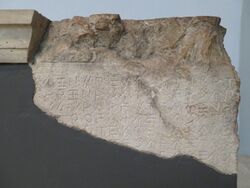Social:Lycian alphabet
| Lycian | |
|---|---|
| Type | Alphabet
|
| Languages | Lycian language |
Time period | 500-330 BC |
Parent systems | Phoenician
|
Sister systems | Carian, Lydian, Phrygian |
| Direction | Left-to-right |
| ISO 15924 | Lyci, 202 |
Unicode alias | Lycian |
| U+10280–U+1029F | |
The Lycian alphabet was used to write the Lycian language of the Asia Minor region of Lycia. It was an extension of the Greek alphabet, with half a dozen additional letters for sounds not found in Greek. It was largely similar to the Lydian and the Phrygian alphabets.
The alphabet
The Lycian alphabet[1][2] contains letters for 29 sounds. Some sounds are represented by more than one symbol, which is considered one "letter". There are six vowel letters, one for each of the four oral vowels of Lycian, and separate letters for two of the four nasal vowels. Nine of the Lycian letters do not appear to derive from the Greek alphabet.
Numbers
Lycian uses the following number symbols: I (vertical stroke) = 1, < ("less than" sign) (or, rarely, L or C or V or Y) = 5, O (circle) = 10; a horizontal stroke — is one half;[5] a symbol somewhat like our letter H may mean 100.[6]
The number 128½ would therefore be expressed as HOO<III—.
Unicode
The Lycian alphabet was added to the Unicode Standard in April, 2008 with the release of version 5.1. It is encoded in Plane 1 (Supplementary Multilingual Plane).
The Unicode block for Lycian is U+10280–U+1029F:
See also
- Letoon trilingual
- Lycian language
Notes
- ↑ Adiego (2007) page 764.
- ↑ Bryce (1986) pages 56-57.
- ↑ Bryce, T. R. (January 1986). "The Pronunciation of Delta in Greek and Lycian". Classical Philology 81 (1): 56–58. doi:10.1086/366958. First page displayable no charge.
- ↑ Bryce (1986) page 58.
- ↑ Laroche, Emmanuel (1979). "L'inscription lycienne". Fouilles de Xanthos VI: 51–128: 100–101.
- ↑ Melchert, H. Craig. "The Trilingual Inscription of the Létôon. Lycian Version". http://www.achemenet.com/pdf/lycian/lyletoon.pdf.
References
- Adiego, I. J. (2007). "Greek and Lycian". in Christidis, A. F.; Arapopoulou, Maria; Chriti, Maria. A History of Ancient Greek From the Beginning to Late Antiquity. Chris Markham (trans.). Cambridge University press. ISBN 978-0-521-83307-3.. Translator Chris Markham.
- Bryce, Trevor R. (1986). The Lycians - Volume I: The Lycians in Literary and Epigraphic Sources. Copenhagen: Museum Tusculanum Press. ISBN 87-7289-023-1.
- Roger D. Woodard, 2007, The Ancient Languages of Asia Minor.
External links
- Everson, Michael (2006-02-05). "N3019R2: Proposal to encode the Lycian and Lydian scripts in the SMP of the UCS". DKUUG Standardization. Danish Unix User Group (DKUUG). http://std.dkuug.dk/jtc1/sc2/wg2/docs/n3019.pdf.
 |


